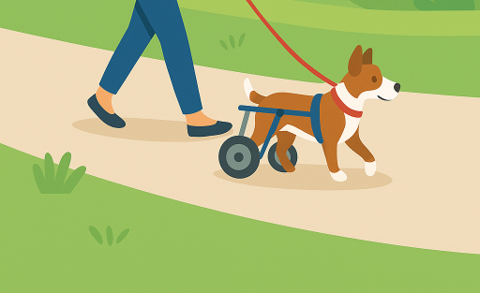back recovery education
The Back Recovery Education program teaches pet owners how to support their dog’s healing after surgery or during conservative management for (IVDD). It provides clear guidance on crate rest, mobility assistance, bladder care, and activity. With compassionate instruction and visual demonstrations, owners learn how to keep their dog safe, progressing confidently through every stage of recovery.
✺ Frequently asked questions ✺
-
Any dog owner whose pet has IVDD or had back surgery.
-
No. You’ll learn how to use simple things at home to keep your dog safe.
-
No. This course supports your veterinarian’s plan—nothing can replace veterinary care.
-
Talk with your veterinarian — they can often make a treatment plan based on your dog’s symptoms and exam, and may suggest lower-cost options or payment plans.
-
As soon as your dog is diagnosed with IVDD, with or without surgery.
-
You’ll have lifetime access, including all updates and bonuses.
-
That’s okay. We’ll show you how to help your dog safely until your vet says rehab can begin.
-
Yes — this course explains how to understand your dog’s chances of walking again, what signs show nerve healing, and how to support recovery at every stage.
Quick Overview
-

Recovery Education
Back injury or surgery can feel scary and confusing. When your best friend can’t walk or move like normal, it’s hard to know what to do. This course explains what happens in your dog’s back, how healing works, and what you can do at home to help your dog feel safe and cared for.
-

A Healing Roadmap
This course breaks recovery into easy steps. You’ll learn what to expect with non-surgical management or after surgery. Learn how to set up your home, ways to help your dog stay calm, how to move your dog safely, what is normal during recovery, and when to contact your veterinarian.
-

Hope and Confidence
Caring for a dog with a back injury is emotional. It takes time and patience. This course gives you the knowledge and tools you need to feel confident helping your dog heal—one day at a time.
six things you’ll learn
-
Understand what happens in your dog’s spine and why discs can rupture.
-
Learn the difference between surgery and rest care, and how to talk to your veterinarian to decide what’s right for your dog.
-
Create a safe, comfortable space with good traction to protect your pet during recovery.
-
Know what’s normal, what’s not, and when to call your vet.
-
Learn how to safely move your pet and what assistive device options are available.
-
Support both your dog’s and your own feelings through calm routines and happy moments.
This course is for education only. It is not veterinary care or physical therapy treatment.
Everything here is meant to support your pet at home within the guidelines of your veterinary care team.
IMPORTANT NOTE
RED FLAGS
When to call your veterinarian
-
If your pet is crying, shaking, hiding, or won’t move, they might be in a lot of pain. Pain means something is wrong, like an injury or illness. A vet can find the cause and give medicine or treatment to help them feel better.
-
If your pet suddenly can’t move their legs, it’s a serious emergency. It could be from a back or nerve injury. A vet needs to see them right away to help prevent permanent damage and pain.
-
If your pet can’t pee, it’s an emergency. It could mean their bladder is blocked, which can make them very sick or even be life-threatening. A vet needs to fix the problem right away to keep your pet safe.
-
If your pet won’t stand on one leg, it could be broken or sprained. Trying to walk on it could make it worse. A vet can evaluate your pet and make sure your pet gets the right care to heal.
back recovery course content
Module 3B – The First Weeks without surgery (days 1-14)
What’s normal and what’s not after surgery
How to set up a crate for comfort and safety
Medications, wound care, and gentle handling
Bathroom breaks and sling support
Module 5 – The Healing Timeline
What to expect each week
Warning signs that mean stop and call your vet
How to keep your dog calm and happy
Module 7 – Emotional Care
Handling worry, guilt, and frustration
Keeping your dog’s mind busy and happy
Building new routines together
Module 1 – Understanding IVDD
What IVDD is and why it happens
How spinal cord injuries progress
Why quick care matters
Types of disc problems
Module 2 – Making Decisions for Your pet
Surgery vs. rest care
How to talk to your veterinarian
What to expect with each option
How to balance care, cost, and quality of life
Module 3A – The First Weeks Home after surgery (Days 1–14)
What’s normal and what’s not after surgery
How to set up a crate for comfort and safety
Medications, wound care, and gentle handling
Bathroom breaks and sling support
Module 4 – Creating a Safe Home
Ramps, rugs, and no-jump rules
Carrying and helping your dog safely
Setting up a calm day and night routine
Module 6 – safe mobility
Gentle range-of-motion work
When to see your PT and rehab team
Core and balance tips
Module 8 – Living Fully with IVDD
What recovery success looks like
Real stories of healing and hope
How to return to safe play and walks
